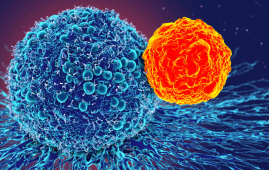

According to new research published in the European Journal of Allergy and Clinical Immunology, the Basophil Activation Test (BAT) can be used to detect allergies and predict the severity of allergic reactions better than traditional clinical criteria.
The Basophil Activation Test to Diagnose Food Allergy (BAT2) Study, conducted by Professor Alexandra Santos of King’s College London, sought to determine whether BAT testing may be used to predict the probability of severe allergic reactions and/or low reactivity thresholds.
For the study, 150 children were selected from specialized tertiary Paediatric Allergy clinics in London and subjected to a double-blind placebo-controlled food challenge to detect potential sensitivities to baked eggs. Patients that cleared this proceeded through a similar process, but this time with loosely cooked egg, with allergic reactions categorized according to Practical recommendations.
According to the findings, BAT was the greatest biomarker for predicting the severity and threshold of allergic reactions to baked eggs, with 75% and 71% accuracy, respectively. The findings suggest that in clinical practice, BAT could be used to assist identify allergies and minimize unintended and potentially severe reactions.
“Being able to identify patients who are more at risk of severe reactions or of reacting to small amounts of the allergen is very important so that we can implement measures to ensure such patients are safe and well-informed about their allergies.” – Professor Alexandra Santos
Food allergies are ubiquitous, and the severity of allergic reactions in the UK has tripled in the previous three decades. However, there is presently no mechanism to precisely identify children who are at risk of severe allergy reactions and/or reacting to tiny quantities of allergen.
The findings have ramifications for a huge proportion of the world’s population who suffer from food allergies, and they show that there is an easy technique to identify people at risk of severe allergic reactions, particularly to common foods like egg.
“It was striking that, when we looked at the children that, during the conduct of the study, we had identified as high-risk, there was an equal proportion of high-risk children among children who developed severe reactions and children who had mild or moderate reactions during the egg challenges. This observation clearly highlights that we are currently not able to identify high-risk groups based on clinical criteria. The basophil activation test showed to be the best predictor of severity and threshold, and could be very informative in clinical practice.”- Professor Alexandra Santos
Other characteristics of the children studied, such as age, gender, ethnicity, previous allergic reactions to egg, previous consumption of egg, history of eczema, asthma, allergic rhinitis, skin prick test, or specific IgE, did not differ significantly between children with severe versus non-severe reactions, or between children who react to low versus higher amounts of egg.
more recommended stories
 T-bet and the Genetic Control of Memory B Cell Differentiation
T-bet and the Genetic Control of Memory B Cell DifferentiationIn a major advancement in immunology,.
 Ultra-Processed Foods May Harm Brain Health in Children
Ultra-Processed Foods May Harm Brain Health in ChildrenUltra-Processed Foods Linked to Cognitive and.
 Parkinson’s Disease Care Advances with Weekly Injectable
Parkinson’s Disease Care Advances with Weekly InjectableA new weekly injectable formulation of.
 Brain’s Biological Age Emerges as Key Health Risk Indicator
Brain’s Biological Age Emerges as Key Health Risk IndicatorClinical Significance of Brain Age in.
 Children’s Health in the United States is Declining!
Children’s Health in the United States is Declining!Summary: A comprehensive analysis of U.S..
 Autoimmune Disorders: ADA2 as a Therapeutic Target
Autoimmune Disorders: ADA2 as a Therapeutic TargetAdenosine deaminase 2 (ADA2) has emerged.
 Is Prediabetes Reversible through Exercise?
Is Prediabetes Reversible through Exercise?150 Minutes of Weekly Exercise May.
 New Blood Cancer Model Unveils Drug Resistance
New Blood Cancer Model Unveils Drug ResistanceNew Lab Model Reveals Gene Mutation.
 Healthy Habits Slash Diverticulitis Risk in Half: Clinical Insights
Healthy Habits Slash Diverticulitis Risk in Half: Clinical InsightsHealthy Habits Slash Diverticulitis Risk in.
 Caffeine and SIDS: A New Prevention Theory
Caffeine and SIDS: A New Prevention TheoryFor the first time in decades,.

Leave a Comment